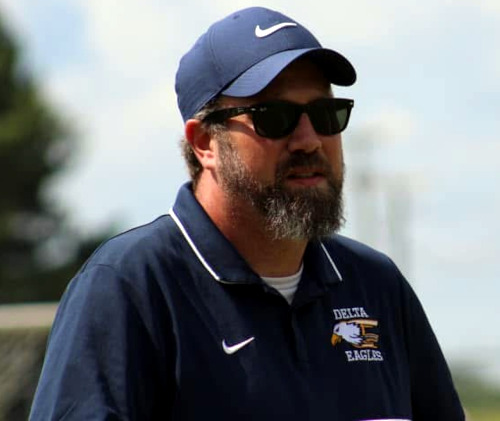By Cooper Pierce
In 1964, Bob Dylan released his third studio album, The Times They Are A-Changing. The album peaked at No. 20 on the U.S. charts, went gold, and reached No. 4 in the United Kingdom the following year.
Dylan wrote the album as an attempt to create an anthem for change in society at the time. Now, 61 years later, the album is still used to illustrate how things are constantly changing.
This is a phrase that IHSAA commissioner Paul Neidig commonly uses when talking about the new changes to the IHSAA transfer rules.

Since the 2012-13 school year, the IHSAA has made 26 changes to Rule 19 (Eligibility and Transfers) of the IHSAA Member School Bylaws. This rule deals with student-athletes transferring from one school to another and outlines the regulations.
The latest changes were proposed to the Executive Committee during a February meeting.
Later, in an annual meeting on May 5, the new bylaws were presented to the IHSAA Board of Directors to be formally approved. The new bylaws will officially take effect on June 1.
Before this year’s changes, Rule 19 bylaws included a principal waiver. This meant that both the sending and the receiving schools had to agree to grant full eligibility to the transferring student that same year.
This caused many problems for transferring students because some of the sending schools did not agree to allow the student to have full eligibility. This forced the students to wait a year before being allowed on the varsity team.
However, with the new bylaws, student-athletes who are still in their first six semesters of high school will be allowed a one-time transfer and maintain full eligibility.
These rules also only apply to freshmen, sophomores, and juniors who are moving from an IHSAA school to another IHSAA school. The exceptions to these bylaws are seniors or any transfers from non-IHSAA schools, which will still be handled as they have in the past.
Additionally, if a student decides to transfer back to their original school, they will retain full eligibility only if it happens within 365 days of their enrollment date at the previous school.
“That’s what’s happening, you know. The landscape of politics, the landscape of parents and student athletes, all those types of things are changing,” said athletic director Tilmon Clark.
As the athletic director, Tilmon oversees any student-athletes transferring to and from Delta. With these new bylaws, Tilmon thinks that these changes will have both a positive and a negative impact on schools.
He believes this will give students and their families more freedom to make the right changes to improve their health. For example, if students needed something new to help their mental health, he said a “change of scenery” would be positive.
However, transferring for the wrong reasons can impact everyone negatively. That’s why Tilmon wants students to put their education first.
“At the end of the day, we are education-based athletics,” he said. “We’re not the NCAA, and we’re not a professional league, so we’re in the business to develop our student-athletes for a better future.”
Like the NCAA, the IHSAA has regulations on how coaches can recruit players.
Rule 20 explains that it is illegal to have undue influence when a player is in the process of moving schools. This means in high school that coaches and schools still cannot directly recruit players.
If a student-athlete’s transfer is found to have been impacted by undue influence, there will be consequences for both the student and the school that is benefited. The transferring student, following a recruitment using undue influence, will be ineligible at the new school for 365 days starting on the date of enrollment. The schools that are found to have benefited from the illegal recruitment will be subject to sanctions determined by Commissioner Neidig.
Some people may see the changes to Rule 19 and think they will drastically change the fabric of high school sports. However, Tilmon doesn’t believe much will change for him.
He already tries to prioritize the experience of our coaches and players, so he said a rule change isn’t going to affect him.
Tilmon agrees with some of the other coaches at Delta that the number of transfers will vary depending on the size and location of the schools. He says that the larger schools in places like Indianapolis or Fort Wayne will see more action before the chaos levels out after the first few years.
Smaller, more rural schools like Delta may see a few transfers, but not nearly as many as larger city schools.
“It’s a year-by-year, team-by-team, case-by-case situation. I don’t expect the flood gates to open by any means,” Tilmon added.
But what is going to make Delta stand out is the community and student-athlete experience.
Tilmon puts it best by saying that students will join us at Delta if they want to be part of something special. He knows how successful Delta’s academics and athletics are, so he understands why some students may want to move here.
While Tilmon oversees student-athletes moving to Delta, the coaches will be directly affected by the new additions to their team. Girls’ head basketball coach Tyronda Benning is split on what to think of these new bylaws.

On one hand, she believes that it will be good to see students be able to choose wherever they want to go. On the other hand, she thinks it will “make it a little bit sticky” for the students already attending those schools. Big role players, especially from previous seasons, may question what future seasons have in store for them.
Some may argue that adding or losing players due to the new rules can hurt a team’s chemistry. However, to Benning, the impact on chemistry shouldn’t be important. It should be how well her players can adapt to the team and how quickly they can accept the way it functions.
“Either you’re on board or you’re out of there,” Benning said. “Anyone who comes here will have to abide by what we already have here, and that’s a family.”
Boys’ head soccer coach Tony Pierce favors the new changes.

He says that having more student-athletes who play soccer join his team would be greatly beneficial in the long run.
Pierce said his goal is to develop his team to the point where there is a culture of success. He said having more players on the team would allow him to build a better base for the program, so that the success can continue for many years.
However, Pierce says he doesn’t want to see students transfer for the wrong reasons either. This is why he hopes that the rules will only stay as a one-time transfer, and not like the NCAA, which “allows players to jump around however they like.”
While everyone has their own opinions, nothing is for certain in terms of how these rules will affect Delta. But one thing you can count on is that the times for Delta athletics are changing.






